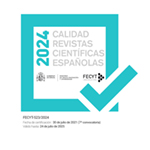El color del canto. El paralelismo en la pintura teotihuacana
Resumen
La relación entre expresiones pictóricas y correspondientes enunciaciones orales es un tema ampliamente debatido en los estudios mesoamericanos, en donde la discusión se ha centrado mayoritariamente sobre los códices posclásicos y coloniales. Buscando profundizar el horizonte cronológico de este tipo de estudios, el presente artículo discute algunas pinturas murales teotihuacanas con el objetivo de identificar posibles correspondencias estructurales entre imágenes y enunciaciones lingüísticas. Después de introducir la discusión hasta la fecha llevada a cabo sobre el problema de la relación imagen-enunciación oral, se comenta un “conjunto gráfico de significado” (así como definido por Mikulska 2015) teotihuacano, conocido como four element group, que parece ser un antecedente de análogos conjuntos gráficos posclásicos que tienen una correspondencia con difrasismos conocidos en lenguas indígenas como el náhuatl. El segundo caso de estudio comentado a continuación es un detalle de una pintura mural de Tepantitla (Teotihuacan) la cual demuestra una estrecha correspondencia – no solo temática sino que estructural – con parte de un canto náhuatl registrado en la Psalmodia Christiana (1583) de Bernardino de Sahagún. Los dos ejemplos sugieren que en las expresiones visuales teotihuacanas se pueden individuar los antecedentes de formas expresivas paralelísticas – tanto visuales como orales – que tuvieron un importante desarrollo en las sucesivas épocas de la historia mesoamericana.
Descargas
Descarga artículo
Licencia
La Revista Española de Antropología Americana, para fomentar el intercambio global del conocimiento, facilita el acceso sin restricciones a sus contenidos desde el momento de su publicación en la presente edición electrónica, y por eso es una revista de acceso abierto. Los originales publicados en esta revista son propiedad de la Universidad Complutense de Madrid y es obligatorio citar su procedencia en cualquier reproducción total o parcial. Todos los contenidos se distribuyen bajo una licencia de uso y distribución Creative Commons Reconocimiento 4.0 (CC BY 4.0). Esta circunstancia ha de hacerse constar expresamente de esta forma cuando sea necesario. Puede consultar la versión informativa y el texto legal de la licencia.









